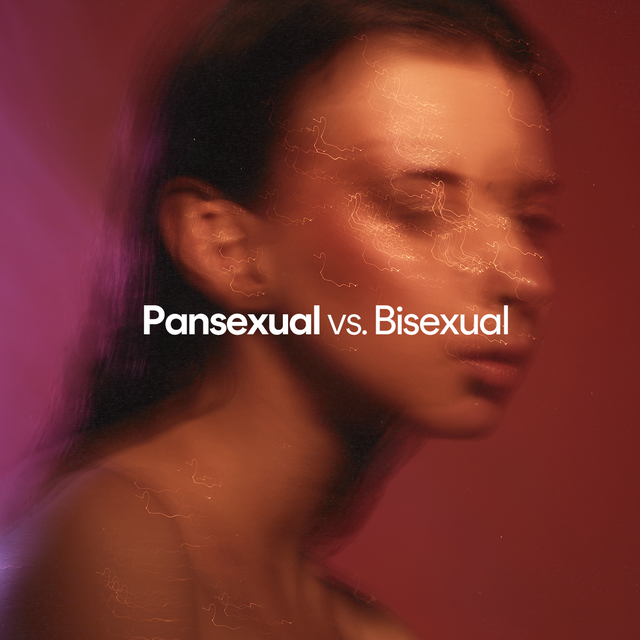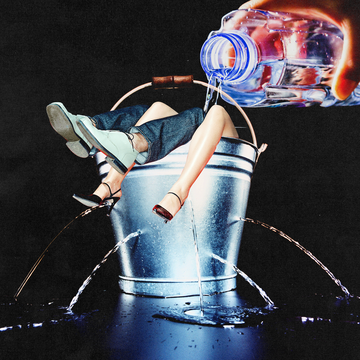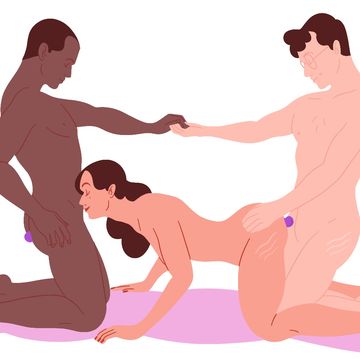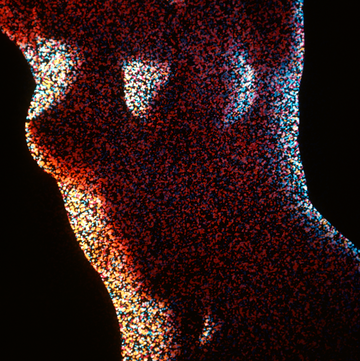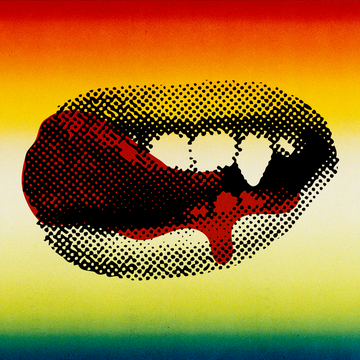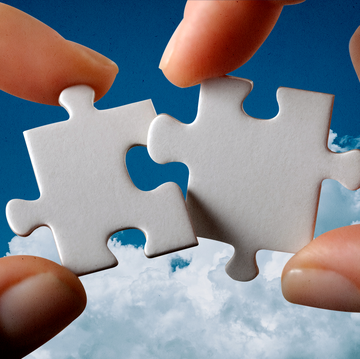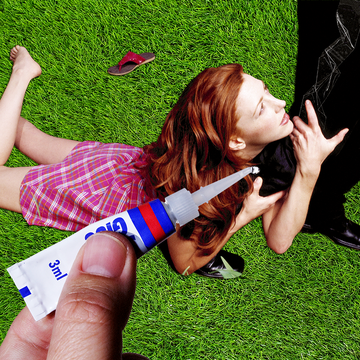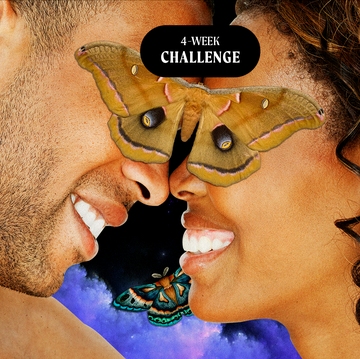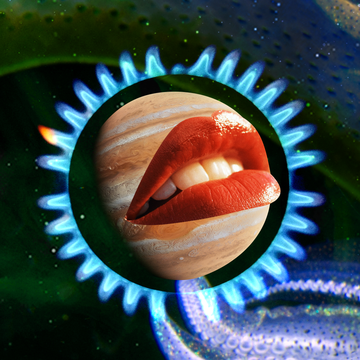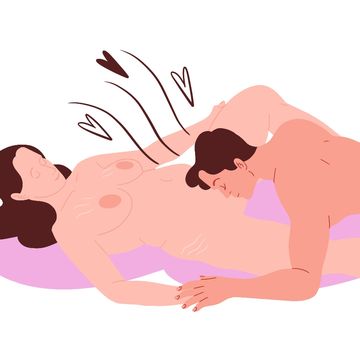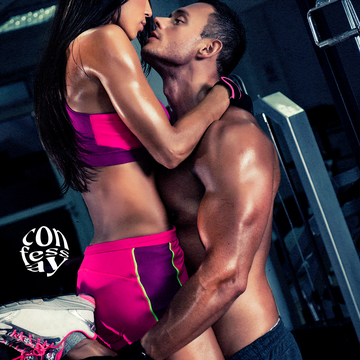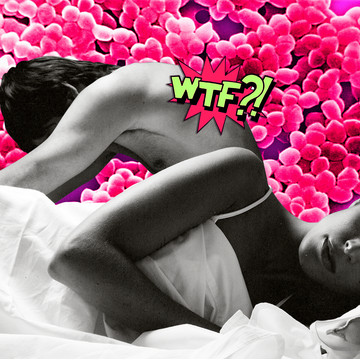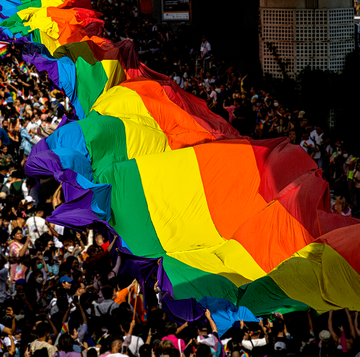Nowadays, it can feel like the terms bisexual and pansexual are used interchangeably—but their definitions aren’t exactly the same. Yes, both terms mean that you’re attracted to more than one gender (including your own), explains sex therapist Jenni Skyler, PhD, director of The Intimacy Institute. But the definitions are even more nuanced, implying deeper meanings that can help better communicate a person’s sexual orientation.
For starters, “a commonly-used definition of bisexuality is ‘attracted to at least two genders’ or ‘attracted to genders like yours and genders different from yours,’” explains Gabrielle Blonder, a member of the board of directors of the Bisexual Resource Center. On the other hand, “pansexuality is often defined as ‘attraction regardless of gender,” says Blonder.
Basically, a bisexual person may have gender preferences, whereas a pansexual person might not take gender into account, focusing on other aspects of a person instead, explains queer therapist and coach Morgan Thomas. Some people may choose to use both bisexual and pansexual as their labels, while others may choose to stick to the one they feel better represents them, adds queer educator and social worker Zoe Stoller.
The bottom line? Experts agree that having different labels is a good thing because it helps individuals feel seen. So whether you’re trying to figure out which term feels more authentic to you, or you’re trying to be a better ally, here’s everything you need to know about bisexuality versus pansexuality, according to experts.
What does it mean to be pansexual?
The “pan” in pansexual means “all” in Greek, which is why the term describes someone who is attracted to any and all genders, explains Stoller. The key here is that gender doesn’t determine attraction, and pansexual people typically don’t prefer one gender over another.
For example, a pansexual person may be attracted to their own gender as well as other genders. However, someone’s gender is not a requirement or determining factor of whether or not they want to date or sleep with you. Remember that quote from Schitt’s Creek? David says he “likes the wine, not the label,” when describing his sexual preferences. Here, he’s describing pansexuality, Stoller says.
It's important to note, however, that sexual orientation (such as pansexuality) is different from gender identity. While sex is typically assigned by doctors at birth depending on genitals, gender is a social construct. People can be whatever gender they feel best suits them, be it male, female, non-binary, genderqueer, or genderfluid, regardless of what the doctor in the birthing room says.
For many pansexual individuals, gender identity is not what makes them be into (or not into) someone. But again, everyone is different, so some pansexual people may have gender preferences—and that’s totally valid. “Pansexual can be seen as a vast spectrum with a variety of experiences,” Stoller explains, so not every pansexual person's experience will look identical.
What does it mean to be bisexual?
In a broad sense, bisexuality is similar to pansexuality. Blonder says one of the most commonly accepted, modern definitions of bisexuality is: “attracted to genders like yours and different from yours.”
This means the “bi” in bisexual doesn’t equal an attraction to *just* two genders, but instead, two or more genders, including your own. So, someone who’s bisexual could be attracted to all genders with or without preference, or someone could be attracted to their own and different genders to different degrees—it’s not a one-size-fits-all kind of thing. “[Bisexuality] is a very open word that contains endless possible experiences,” Stoller explains.
When the term first gained attention, however, Blonder says it was actually a form of gender expression for people who felt both masculine and feminine. From there it became a way to express attraction for men and women, but now, “as our cultural understanding of gender has evolved, so has our community's understanding of bisexuality,” Blonder explains.
As a whole, many different terms—including pansexuality—technically fall under the bisexual umbrella, since the term simply means being attracted to more than one gender. So another way you can look at it is that pansexuality is a subset of bisexuality.
What’s the difference between being pansexual and bisexual?
Even though pansexuality and bisexuality are similar, understanding the differences and similarities is important. Both terms mean being physically attracted to multiple genders, but pansexuality generally takes the focus off gender and more on the person themselves, says Sofiya Alexandra, co-founder and co-host of the Private Parts Unknown podcast. This isn’t because the term is more enlightened, though—it’s simply a matter of language evolution and the natural progression of changing social norms.
What are some misconceptions about pansexuality and bisexuality?
For starters, “some people feel the term bisexual, despite its updated definition and usage, is outdated,” Blonder explains. This is due to the misconception—both in and out of the LGBTQIA+ community—that the term isn’t inclusive of transgender people.
In reality, Blonder says attraction to cis-men and cis-women is no longer seen as an accurate or comprehensive definition of the bi+ experience. “There is a huge misconception that bisexuality is inherently transphobic or adheres to the gender binary,” adds Thomas. “This is not true. Bisexuality includes non-binary and genderqueer people. Not including trans people is not a trait of bisexuality. That stems from transphobia.”
Not only can bisexual people be attracted to trans and non-binary folks, but as with pansexuality, there are trans and non-binary people who are bisexual. In fact, all the experts agree it’s important to stop spreading the falsehood that bisexuality is rooted in the binary. (It’s not!)
This kind of biphobia, in turn, fractures an already-marginalized community, Blonder explains. “It's important to talk and listen to those who use different labels from you before assuming the words they choose to use for themselves are malicious or exclusive,” she says. “Language shifts meaning over time, and many terms now have strongly overlapping definitions.”
That said, there is also the misconception that if you are pansexual or bisexual, when you are dating someone who identifies as a certain gender, that means that you’re no longer attracted (or never really were attracted) to other genders. This idea, however, is also rooted in homophobia and misunderstandings about sexuality, Skyler explains. You can date whoever you want—it will not negate your identification as bisexual or pansexual.
How do you know if you're bisexual or pansexual?
Choosing to use (or not use) a label is a very personal decision, and in this case, neither term is “better” than the other. “Whether folks are one or the other is often more about which feels right to them than about any significant differences in behavior,” says psychologist Liz Powell, PsyD, author of Building Open Relationships.
“‘Bisexual’ as a term was popularized way before ‘pansexual,’” adds Alexandra. “As an older millennial, when I came out, ‘pansexual’ wasn’t a term that was used, so I’ve been bi for decades now. Although it is of course possible to only be attracted to men or women, in my experience, the bisexual community and the pansexual community are the same community, just different ages.” She notes that her friends in their 20s tend to be more comfortable using “pan,” while her older friends use “bi”—and all of them use “queer,” which is an umbrella term for a sexual orientation outside of the heteronormative.
Because “pansexual” is newer than “bisexual,” younger generations like Gen Z typically gravitate toward it, says Powell. Ultimately, you’re allowed to use whichever label feels right for you, even if your experience doesn’t “perfectly” fit the definition. “A person might not relate to the word pansexual at all, and yet when they hear the word bisexual, they have a deep connection to it,” Stoller explains. “Even if their experience might ‘technically’ be defined as pansexual, they’re certainly allowed to use the bisexual label in this case!”
If you’re trying to determine the best label for you, think about which one makes you feel safe, comfortable, and at home. “In those quiet moments, when you’re alone in your own thoughts and feelings, notice what happens to your body when you look at certain people,” explains AASECT-certified sex therapist Janet Brito, PhD, founder of the Hawaii Center for Sexual and Relationship Health.
Brito suggests breaking apart from cultural scripts around sexuality and getting in touch with what feels authentic to you by asking questions like: What are the gender identities of the folks I’m drawn toward? What kind of romantic or sexual relationships do I want for myself, in a world free from others’ input? In a society where heterosexuality is perceived as the social norm, it can be hard to answer such questions honestly and easily, so don’t put pressure on yourself to find the “answers” right away. Sexuality is fluid and a lifelong, personal journey. There’s no rush!
Can you be both bisexual and pansexual? Or do you have to choose a label?
You absolutely do not have to choose a label, says Brito. Your sexuality is personal to you, and if you feel that it’s too much pressure to identify as one thing, that’s fine. In fact, you can even be both bisexual and pansexual if that’s what feels most accurate to you. And if you later decide a different label feels better or your preferences change or language evolves, it’s okay to change labels—or omit them completely—as well.
“Not claiming a label does not make your sexuality less valid than someone who has a defined label,” Thomas says. “Your sexuality can change at any time, and just because you ‘finally found a label,’ that doesn’t mean it won’t ever change.” Ultimately, you can be pansexual, bisexual, queer, or none of the above. Any choice is valid—it just comes down to whatever resonates with you most.
Madeline Howard is a writer, editor, and creative based in Brooklyn. Her work has been published in Esquire, Nylon, Cosmopolitan, and other publications. Among other things, she was formerly an editor at Women’s Health. Subscribe to her newsletter ‘hey howie’ at madelinehoward.substack.com.
Rachel Varina is a full-time freelance writer covering everything from the best vibrators (the Lelo Sona) to the best TV shows (The Vampire Diaries). She has over 10 years of editorial experience with bylines at Women's Health, Elite Daily, Betches, and more. She lives in Tampa, Florida, but did not feed her husband to tigers. When she's not testing out new sex toys (100+ and counting so far!), she's likely chilling with her dogs or eating buffalo chicken dip. Ideally at the same time. Follow her on Instagram and Twitter.
